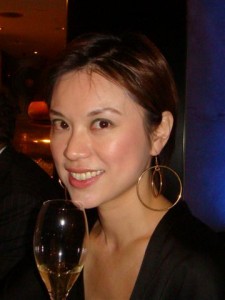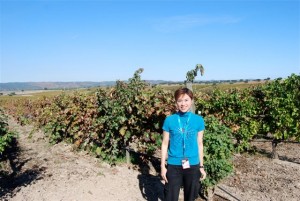By Jim Boyce
Hong Kong-based Rebecca Leung is author of the Wine is Beautiful blog, has written about wine for numerous print publications, hosts an online wine program, has judged at numerous tastings, and most recently was selected to take part in the Landmark Australia tutorial. I asked her about how she started in wine, prospects for the Hong Kong scene, her advice for newcomers to wine, and more.
–

How did you first get interested in wine?
It was my 19th birthday in Canada and I can hardly recall what wine it was, but it was a definitely interesting and delicious experience, and I think I told my mom that I preferred it to beer. Ironically, I was in the beer industry some years after, and I was required to go through some tasting training. I applied the same skills to wine drinking when I dined out with friends, slowly developed a strong passion for learning more about wine, and eventually went to serious wine appreciation classes and many wine tastings. During the early days, I tasted a wide range of wines, but the most inspiring one was the Bass Phillip Pinot Noir from Australia. I love the delicacy of the wine, and I truly admire the attitude of Phillip Jones, the winery owner.
–
You write about wine both for your blog and for the mainstream media. What are the advantages and the disadvantages of each one?
There isn’t any disadvantage at all when it comes to wine writing, as I treat every article as an expression of my wine experience. But I must admit that I enjoy writing my blog more, because there isn’t a word-count limit; there aren’t any deadlines, and it is interactive and multimedia-friendly.
–
Hong Kong had a big year in 2008 – from the dropping of the wine tax to some very big auctions. What’s your take for the year ahead?
Last year, when the Hong Kong government announced its ambition of being a world wine hub, there was a lot of controversy. A year has passed and we can see that Hong Kong has doubtlessly become Asia’s major wine hub. Despite the influence of the financial crunch, this year Hong Kong will continue to be the focus in Asia, as it will hold the Asian wine competition as well as many more major wine auctions throughout the year. The level of wine knowledge of consumers and trade people here has improved drastically.
–
When you meet someone new to wine, what advice do you give them?
One can get intimidated with the wine speak on labels. The best (or actually, only) way to overcome this is to taste and learn. Most of the table wines available in the market are dry wines (also known as light wines), i.e. “not sweet†wines, and they go well with most dishes. Examples are Bordeaux and Burgundy reds, Italian Barolo, or Australian Shiraz. Sweet wines can be made in many ways. Some are quite low in alcohol (7%), while some can be as high as 20%. Some typical sweet wines are Germany’s Auslese, Canada’s Icewine and Portugal’s Port wines. Most wines are fruity when they are young, and these fresh fruit characters can evolve complex and mature flavors with time.
–
Looking back on 2008, what was your favorite wine event, your favorite wine bar, and your favorite new wine?
My favorite wine event in 2008 was Vinexpo Asia Pacific in Hong Kong. I met a lot of friends and hosted a seminar. It was a very successful and fruitful event indeed.
I don’t visit wine bars much but I quite enjoyed my experience at Sky Lounge in the Sheraton Hotel. They introduced the wine vending machine and have created a trend in the market.
I have had a lot of nice new wines this year. The most exciting one was the 2004 Cortes de Cima Syrah I had when I visited their winery in Alentejo, Portugal last October. This Syrah was stunningly aromatic with spice and blueberry scents, ripe and concentrated fruits, a firm texture, and a clean finish. More and more quality Syrah varietals are made in this arid region.
–
What are you drinking these days?
Two weeks ago I was in Macau, where you can easily find a lot of tasty Portuguese wines. I had a bottle of 2005 Cartuxa Tinto Colheita, a very elegantly structured red wine blend (made with Trincadeira, Aragonez, Alfrocheiro, etc.) from Alentejo, Portugal.
At home for dinner last night, I had a 2007 Dashwood Pinot Noir from Marlborough, New Zealand. Refined, and elegant with vibrant red fruit, the wine was delightfully crispy.

Sign up for the Grape Wall newsletter here. Follow Grape Wall on LinkedIn, Instagram, Facebook and Twitter. And see my sibling sites World Marselan Day, World Baijiu Day and Beijing Boyce. Grape Wall has no advertisers, so if you find the content useful, please help cover the costs via PayPal, WeChat or Alipay. Contact Grape Wall via grapewallofchina (at) gmail.com.
On Cortes de Cima behalf
å¦å…‹ä½ Rebecca!